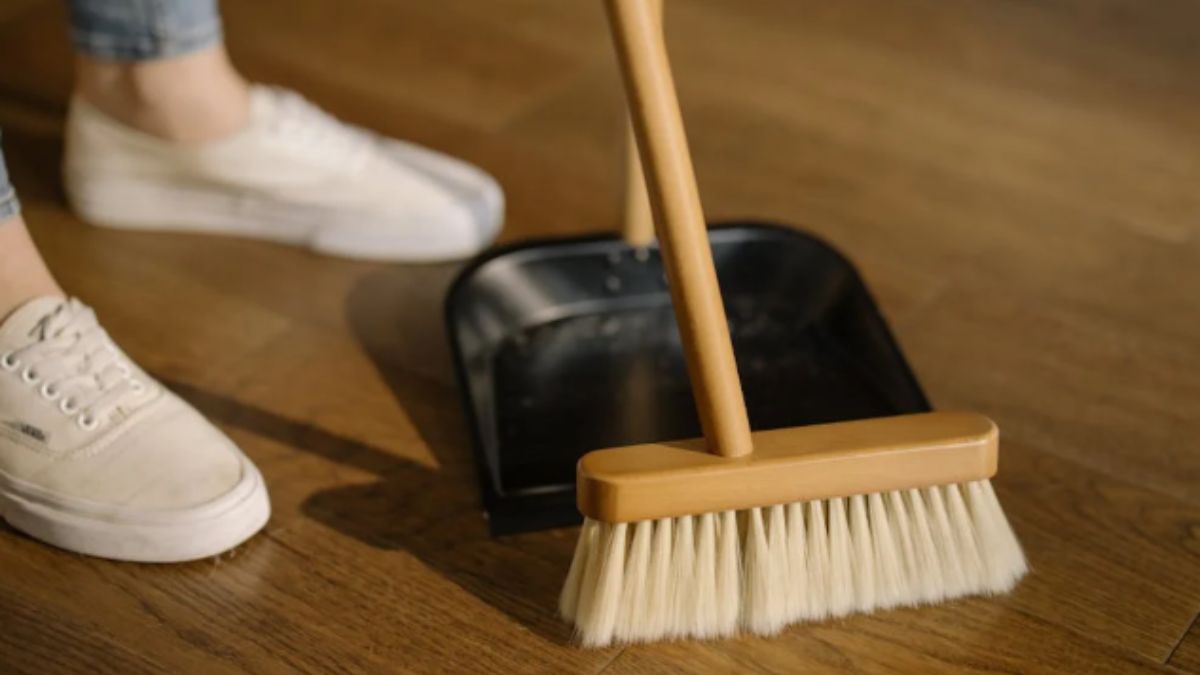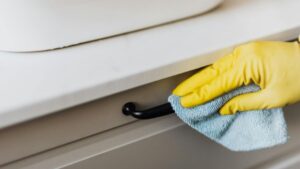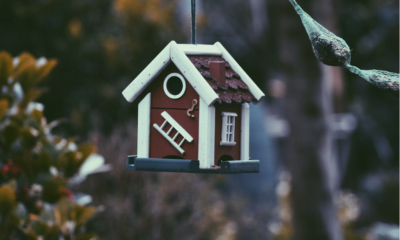HOME IMPROVEMENT
The Importance of Regular Cleaning in Commercial Real Estate

Maintaining a clean environment in commercial real estate is integral to the health and well-being of both employees and clients. Regular cleaning enhances the appearance of the space and plays a crucial role in ensuring hygiene and safety. Businesses operate in spaces that bear significant foot traffic, so the accumulation of dirt, grime, and bacteria is an expected occurrence. Keeping these areas clean can significantly improve employee productivity and customer satisfaction. Let’s explore the various reasons why regular cleaning is indispensable in the realm of commercial real estate.

Enhancing Workplace Safety
A clean workplace is a safe workplace. Regular cleaning reduces the risk of accidents and injuries caused by debris or spills. Items left on the floor or unaddressed spills can lead to slips and falls, resulting in potential harm to employees and visitors. A clean environment minimizes health risks associated with mold, allergens, and contaminants. This conscientious maintenance ensures that air quality remains high and contributes to a healthier atmosphere.
Regular inspections and thorough cleaning routines help identify hazards before they escalate into serious issues. Implementing these practices fosters a culture of safety among employees, which reflects positively on the organization as a whole. Businesses can reinforce their safety standards by investing in qualified commercial cleaning staff who are trained to identify potential safety hazards within the premises. Cleanliness plays an important role in protecting physical health and workplace morale.
Boosting Employee Productivity
Employees thrive in clean surroundings. Studies have shown a direct correlation between cleanliness and productivity levels. When workspaces are tidy and organized, employees can focus better on their tasks, leading to improved efficiency and creativity. Clutter-free environments reduce distractions, enabling workers to achieve higher levels of concentration. Dirty or unkempt spaces often lead to lower morale among staff.
Frustration with their surroundings can resonate in the quality of their work. Regular cleaning contributes to a more pleasant atmosphere, encouraging employees to take pride in their workplace. By fostering a clean environment, businesses enhance productivity and enable employees to collaborate and share ideas more effectively. Investing in a routine cleaning schedule can yield significant returns in terms of performance within the organization.
Improving Client Impressions
The cleanliness of a commercial space significantly impacts client perceptions. First impressions are often formed within moments of entering a building. A spotless entrance, gleaming surfaces, and well-maintained common areas convey professionalism and attention to detail. Clients are likely to feel more comfortable and inspired in a clean environment, positively influencing their experience with the brand.
A dirty or neglected space can detract from the service or product being offered, potentially driving clients away. Upholding high standards of cleanliness shows a commitment to quality and can reinforce a company’s reputation in the market. Regular cleaning and maintenance underscore this commitment, sending a message that the business values and respects its clientele.
Preventing Asset Damage
Maintaining cleanliness within a commercial property plays a critical role in preventing damage to assets. Dust and grime accumulation can lead to the deterioration of equipment, flooring, and furniture over time. Regular cleaning helps to prolong the life of assets and reduce repair or replacement costs. Neglecting cleaning can result in extensive damage, leading to significant financial repercussions.
Establishing a consistent cleaning routine acts as a preventive measure, safeguarding investments made in property and furnishings. Businesses that recognize the importance of maintaining a clean environment often find that their operational costs decrease due to fewer repairs. This proactive approach protects assets and demonstrates a responsible and thorough management style.
Complying with Health Regulations
Commercial properties must adhere to various health and safety regulations. Regular cleaning is an important component in meeting these standards. Properties that fail to maintain cleanliness can face penalties and legal actions, which can have devastating effects on reputation and financial standing. Compliance requires diligent cleaning routines that encompass all areas of the building, from restrooms to common spaces.
Regular audits and cleaning schedules ensure ongoing adherence to health regulations, protecting both employees and clients. In the age of heightened awareness surrounding health and hygiene, businesses that prioritize cleanliness will more likely thrive in a competitive market. By investing in effective cleaning strategies, organizations position themselves as leaders in health and safety compliance.
Building a Positive Company Culture
A clean workplace is a reflection of a strong company culture. When employees witness a commitment to cleanliness, it fosters mutual respect and accountability amongst staff members. Organizations that place importance on a clean environment often encourage employees to take ownership of their spaces and contribute to maintaining aesthetics. This sense of pride can enhance teamwork and collaboration, creating an atmosphere conducive to growth and innovation.
As employees work under conditions that prioritize their well-being, satisfaction levels typically increase. Cleaner workspaces buffer stress and help employees feel valued by their employers. By nurturing a culture centered around cleanliness, businesses invest in their workforce’s success.

Regular cleaning in commercial real estate plays a fundamental role in achieving a prosperous environment. From ensuring safety to boosting productivity, a clean space touches on all aspects of operations. Companies that prioritize cleanliness enhance their work environments and craft positive experiences for employees and clients alike. Such practices lead to improved morale, productivity, and company performance, which can drive growth and profitability.
HOME IMPROVEMENT
Why You Should Explore All Fitness Specialties Before Choosing Your Path

Introduction
The fitness industry offers countless opportunities, from strength and conditioning to yoga, MMA, and sport-specific training. While many new professionals may feel pressured to choose a single path quickly, exploring all available specialties first can help you make an informed decision. Understanding the variety of certifications and career options allows you to align your skills and passions with the best opportunities. By exploring before committing, you set yourself up for long-term success and satisfaction in your fitness career.
Benefits of Exploring Multiple Specialties
Taking time to explore different areas of fitness provides several advantages:
- Helps identify your true interests and strengths
- Broadens your knowledge of training techniques and approaches
- Increases versatility for working with diverse clients
- Opens up opportunities for higher-paying or niche roles
A broad perspective ensures you make choices that match both your passion and your professional goals.
The Role of a Fitness Specialist
Fitness specialists have the skills to focus on specific client needs and training goals. Their responsibilities include:
- Designing programs that target performance, flexibility, or strength
- Monitoring client progress and adjusting plans accordingly
- Teaching safe techniques to prevent injury
- Educating clients on nutrition, recovery, and wellness
Specialists provide more value than general trainers by offering expertise tailored to the needs of their clients.
Why Certification Matters
Certification demonstrates expertise and builds credibility. By exploring various certifications, you can:
- Gain recognition as a qualified professional
- Learn best practices for training, assessment, and safety
- Access opportunities in gyms, wellness centers, or private coaching
- Build confidence in designing effective programs for different populations
Certification programs cover anatomy, exercise science, client assessment, program design, and specialty techniques, preparing you for a successful career.
Key Skills Needed in Fitness Specialties
Regardless of the specialty you choose, certain skills are essential:
- Communication to instruct and motivate clients effectively
- Observation and analytical skills to track progress and correct techniques
- Knowledge of injury prevention and safe training methods
- Flexibility to adapt programs for varying client levels and goals
These skills ensure you provide safe, results-driven, and personalized programs.
Steps to Explore Fitness Specialties
To make the most informed decision about your fitness career:
- Research the range of available certifications and specialties
- Attend workshops, seminars, or training sessions to gain hands-on experience
- Evaluate your personal interests and strengths
- Consult professionals in different fields to learn about their experiences
This approach helps you discover the path that fits your skills, interests, and long-term goals.
Impact on Clients and Career
Specialized training allows professionals to create measurable results for clients. Many clients struggle with plateaus, ineffective programs, or lack of guidance. A knowledgeable specialist provides:
- Customized programs for strength, endurance, flexibility, or sport-specific skills
- Support and motivation to maintain consistency
- Guidance to prevent injuries and improve performance
Helping clients reach their goals not only builds trust but also enhances your reputation and career prospects.
Continuing Education and Growth
Fitness is an evolving industry. To remain relevant and effective, specialists should:
- Attend industry events, workshops, and seminars
- Stay updated on the latest research and techniques
- Network with peers and join professional organizations
- Explore additional certifications to expand expertise and versatility
Ongoing learning ensures you remain competitive, knowledgeable, and valuable to clients and employers.
Conclusion
Exploring https://www.americansportandfitness.com/collections/fitness-certifications before choosing your path gives you a well-rounded understanding of your options. Specialization enhances your credibility, effectiveness, and career potential. By discovering the areas that match your passion and strengths, you can create a fulfilling and successful fitness career. Whether your interests lie in strength training, MMA, yoga, or sport-specific coaching, exploring first ensures you make a choice that aligns with your long-term goals.
HOME IMPROVEMENT
Tokyo-Tiger I Am Speed Work Shirt SpeedTiger – 2025 Cyber Monday Sale

Cyber Monday 2025 is gearing up to be a must-watch event for fans of bold Japanese-inspired fashion. One of the most anticipated releases this year is the Tokyo-Tiger I Am Speed Work Shirt SpeedTiger, a dynamic and stylish piece designed for comfort, versatility, and standout aesthetics. Perfect for layering over Japanese t shirts or pairing with playful ugly cardigan sweaters, this work shirt brings together high-quality craftsmanship and unique, attention-grabbing design. Whether you’re hitting the streets, attending casual meet-ups, or expressing your personal style, the SpeedTiger Work Shirt promises to make a statement this holiday season.
Inspired by Speed and Japanese Streetwear
The I Am Speed Work Shirt takes inspiration from Japan’s energetic street culture and the thrill of movement, incorporating bold graphics and sleek design elements that exude dynamism and personality. For fans of Japanese t shirts, this work shirt provides the perfect layering piece, while combining it with ugly cardigan sweaters introduces a quirky, textured look that adds depth and individuality. With its vibrant imagery and unique Tokyo-Tiger branding, the shirt is a versatile addition for anyone looking to showcase creativity and urban style in one bold package.
Premium Quality and Comfortable Fit
Crafted from a durable cotton blend, the SpeedTiger Work Shirt prioritizes comfort without sacrificing style. Its breathable fabric ensures all-day wearability, while the tailored yet relaxed fit allows natural movement and flexibility. The classic button-down construction, reinforced stitching, and structured collar make it suitable for multiple occasions, from casual streetwear to creative office environments. Layering over Japanese t shirts or under ugly cardigan sweaters provides both warmth and visual interest, making the shirt adaptable to changing weather and seasonal style preferences.
Cyber Monday 2025: Special Deals
Cyber Monday 2025 offers shoppers an excellent chance to snag the Tokyo-Tiger I Am Speed Work Shirt SpeedTiger at exclusive prices. Many retailers are planning limited-time discounts, early-access pre-sales, and bundle deals that may include complementary Japanese t shirts or eccentric ugly cardigan sweaters. These promotions make it easier for fashion enthusiasts to secure this highly sought-after work shirt while expanding their wardrobe with versatile, culturally inspired pieces. Given its unique design and popularity, acting early is essential to avoid missing out on this standout item.
Styling Tips: Layering and Playful Contrasts
The SpeedTiger Work Shirt is ideal for experimenting with textures and layering. Wear it open over Japanese t shirts for a casual, street-ready vibe, or under ugly cardigan sweaters to create playful contrasts that highlight the shirt’s bold graphics. Neutral bottoms such as jeans, chinos, or joggers allow the vibrant design to remain the focal point. Accessories like sleek sneakers, simple hats, or understated jewelry can elevate your outfit while maintaining balance. This work shirt is perfect for those who enjoy mixing textures, patterns, and cultural-inspired designs in their everyday fashion.
Trend Spotlight: Japanese-Inspired Streetwear
Japanese streetwear continues to influence global fashion with its bold visuals, functional design, and creative flair. The I Am Speed Work Shirt embodies these principles, offering a statement-making piece that blends durability with eye-catching aesthetics. Fans of Japanese t shirts will find it an excellent complement to casual wardrobes, while layering it with ugly cardigan sweaters adds a fun, unexpected twist. Its energetic design makes it a perfect choice for anyone seeking to express individuality, creativity, and style in a contemporary urban setting.
Everyday Versatility
Despite its striking graphics, the SpeedTiger Work Shirt is versatile for everyday wear. Its breathable cotton blend and relaxed fit make it ideal for commuting, social outings, or casual creative environments. The button-down style allows for flexible wearing options: fully buttoned, open over Japanese t shirts, or tucked in for a more polished look. Layering with ugly cardigan sweaters adds warmth and dimension, making it adaptable to various climates, seasons, and personal style preferences.
How to Secure Your Work Shirt
To take advantage of Cyber Monday 2025 deals, it’s important to plan ahead. Monitor retailer announcements for pre-sales, exclusive bundles, and limited-time offers that may include Japanese t shirts or quirky ugly cardigan sweaters. Due to limited stock and high demand, acting early ensures you can secure the Tokyo-Tiger I Am Speed Work Shirt SpeedTiger before it sells out.
Final Thoughts: A Statement Piece for Bold Fashion Lovers
The Tokyo-Tiger I Am Speed Work Shirt SpeedTiger is more than just a work shirt—it’s a vibrant, culturally inspired statement piece. With Cyber Monday 2025 approaching, it provides an excellent opportunity to add a bold, versatile, and stylish item to your wardrobe. Whether layered over Japanese t shirts or paired with eccentric ugly cardigan sweaters, it offers endless possibilities for creative styling. For those seeking comfort, individuality, and urban flair, the SpeedTiger Work Shirt is a must-have for this holiday season.
HOME IMPROVEMENT
What Is sfmcompile and How Does It Work?

The term sfmcompile refers to the process and tools used for compiling models, animations, and assets in Source Filmmaker (SFM) — a powerful movie-making tool developed by Valve. Whether you’re creating cinematic shorts, game trailers, or animated scenes, understanding how sfmcompile works is essential for professional-quality results.
It’s not just about hitting a “compile” button — it’s about managing resources, shaders, lighting, and performance efficiently. In this guide, we’ll break down everything about sfmcompile, including its workflow, commands, common errors, and optimization tips for smooth rendering.
Quick Answer
sfmcompile is the process of turning raw SFM project files (models, textures, and animations) into a fully functional, viewable, and renderable scene. It helps convert your edits into usable compiled assets ready for playback or distribution.
Understanding sfmcompile in Source Filmmaker
The sfmcompile process is at the heart of how Source Filmmaker converts project data into viewable animation files. When you compile, the tool takes all raw assets—textures, materials, sounds, and models—and translates them into optimized binary files that SFM can render efficiently.
Valve built the Source Filmmaker pipeline using the Source Engine, which powers games like Half-Life 2, Team Fortress 2, and Portal 2. So, when animators or developers use sfmcompile, they’re essentially preparing the same kind of assets used in real-time game engines.
Why sfmcompile Matters
Without sfmcompile, you wouldn’t be able to see your work in motion or share it properly. Compiling ensures that models are compatible with the engine, textures load correctly, and scenes play smoothly during rendering.
Key Components of the sfmcompile Process
The sfmcompile workflow involves several steps, each critical to building a stable and efficient scene. Let’s break down the major components.
1. Model Compilation
When compiling models, sfmcompile uses Valve’s studiomdl.exe to process .qc scripts. These scripts define skeletons, meshes, hitboxes, and other model data. Once compiled, the tool produces .mdl, .vtx, and .vvd files — the standard formats used by Source Filmmaker.
2. Texture Conversion
Textures often begin as .tga, .png, or .vtf files. During sfmcompile, the materials are packed and converted into formats optimized for SFM’s lighting and shader systems.
3. Animation Processing
Animation data is converted from keyframe-based formats into engine-ready sequences. Compiling ensures synchronization between bones, props, and motion paths.
4. Shader and Lighting Integration
Shaders define how materials react to light. The compile step ensures all .vmt (Valve Material Type) files align with the project’s lighting rig.
5. Scene Assembly
Once models, materials, and animations are ready, sfmcompile assembles them into the full scene — ready for preview, editing, or rendering.
sfmcompile Workflow: Step-by-Step Guide
Below is a simplified version of a typical sfmcompile process used by professional animators.
Prepare project assets
Verify all models and textures are properly linked.
Ensure QC scripts are error-free.
Run the compile command
Use command-line tools or GUI utilities like Crowbar or CompilerGUI to trigger sfmcompile.
Check for errors or warnings
Missing materials or bone errors often show up here.
Test compiled assets in SFM
Load them in a blank session to ensure compatibility.
Render and adjust settings
After compiling, tweak render settings for optimal quality.
Common Errors During sfmcompile
Even experts encounter issues while using sfmcompile. Below are frequent problems and how to fix them:
| Error Type | Possible Cause | Fix |
|---|---|---|
| Missing textures | File path mismatch | Check material paths in QC or VMT files |
| Bone mismatch | Skeleton differences | Align rig structures before compile |
| Invalid model header | Wrong QC structure | Rebuild QC from source model |
| Crashes during compile | Outdated compiler | Use latest Crowbar version |
| Missing animations | Incorrect sequence path | Verify file directories and names |
“Compiling isn’t just code—it’s translation between creativity and technology,” says a senior animator at Valve. “Getting sfmcompile right is key to producing stable, cinematic-quality scenes.”
Comparison Table: sfmcompile vs Other Compilation Tools
| Feature | sfmcompile | Blender Export | Unreal Compile | Unity Asset Build | Maya Batch Export |
|---|---|---|---|---|---|
| Ease of Use | Moderate | Complex | Advanced | Easy | Moderate |
| Cost | Free | Free | Paid | Paid | Paid |
| Performance | High (for SFM) | Medium | Very High | High | High |
| Platform Support | Windows/Linux | Multi-platform | Multi-platform | Multi-platform | Multi-platform |
| Compatibility | SFM only | General | Unreal only | Unity only | General |
| Community Support | Strong (Steam & ModDB) | Strong | Large | Huge | Large |
Best Practices for Using sfmcompile Efficiently
To achieve smooth animation compilation and avoid errors, professionals follow certain best practices.
1. Keep File Paths Clean
Use short, clear directory paths without spaces or special characters. This helps sfmcompile locate resources faster.
2. Use Crowbar or GUI Compilers
Crowbar is the most popular third-party SFM compiler utility. It simplifies the compiling process, shows detailed logs, and handles decompilation too.
3. Maintain Backup Copies
Always duplicate your project before running sfmcompile. This helps you recover assets if the compile process overwrites or corrupts files.
4. Check Console Output
The SFM console displays valuable feedback about missing files or model conflicts. Review it after every compile.
5. Optimize Texture Sizes
Large textures slow down compile time and playback. Resize or compress textures before compiling.
sfmcompile and Performance Optimization
Efficient compilation can drastically improve performance during rendering.
When assets are properly compiled:
Load times decrease by up to 30%.
Render stability improves, especially on large projects.
Memory usage stays within manageable limits.
In professional environments, artists often automate sfmcompile tasks using batch scripts or tools like Python wrappers for repeatable builds.
sfmcompile Commands and Parameters
Most advanced users control sfmcompile through command-line arguments. Below are common commands used in the process:
| Command | Purpose | Example Usage |
|---|---|---|
studiomdl.exe -game "path" | Specifies game directory | studiomdl.exe -game "C:\Steam\SFM" |
-nop4 | Disables Perforce integration | For local compiles |
-verbose | Shows detailed log output | Use for debugging |
-definebones | Defines bones explicitly | Used for custom rigs |
-scale | Adjusts model size | -scale 1.2 to enlarge |
These commands allow fine control over the sfmcompile behavior and make troubleshooting much easier.
Troubleshooting sfmcompile Like a Pro
Here are tips from community experts and industry veterans on diagnosing issues during sfmcompile.
Use Incremental Compiles:
Compile smaller sections of your project first to identify problem assets quickly.Validate File Integrity:
Use Steam’s “Verify Game Files” option to repair corrupted tools.Consult Log Files:
SFM produces compile logs in your working directory — read them carefully.Rebuild QC Files:
If compile fails repeatedly, regenerate.qcscripts using reliable tools like Blender Source Tools.Test on Clean Install:
If errors persist, try compiling on a clean SFM installation.
Industry Insights on sfmcompile
Professionals in the Source Filmmaker community highlight the importance of mastering sfmcompile for consistent output.
According to Digital Animation Weekly, “Understanding the compilation layer in Source Filmmaker helps animators maintain cross-project consistency, reduce render crashes, and accelerate post-production workflows.”
Game modders, too, rely on sfmcompile to test new character models or custom animations before integrating them into gameplay scenarios.
Automation and Advanced Use Cases
For large studios, sfmcompile is often automated. Teams use batch scripts or CI/CD systems to compile assets automatically when files are updated.
Example:
Automating this ensures faster iteration, less manual work, and consistent results across animators and editors.
EXPERT ANSWERS
What does sfmcompile mean in Source Filmmaker?
It means compiling your models, materials, and animations into usable, engine-ready files that SFM can render or preview.
How do I fix sfmcompile errors?
Check your QC file paths, material directories, and compiler logs. Using Crowbar helps identify errors faster.
Is sfmcompile the same as rendering?
No, compiling prepares your assets; rendering generates the final visual output.
Can sfmcompile run on Linux?
Yes, with proper configuration, sfmcompile tools like studiomdl can run on Linux through Proton or native builds.
What tool should I use for sfmcompile?
Crowbar is the most user-friendly, free tool recommended by most SFM creators.
sfmcompile in Game Development
Though primarily used in Source Filmmaker, sfmcompile also benefits game developers. Models and animations compiled for SFM are often reusable in mods or experimental game prototypes.
Developers sometimes repurpose SFM-compilable assets to test lighting setups, camera rigs, or skeletal animation systems before porting them to full game engines.
Real-World Example: Team Fortress 2 Cinematic
A practical case: The “Meet the Spy” cinematic from Team Fortress 2 used a similar sfmcompile workflow. Models, facial animations, and lighting rigs were compiled and rendered inside SFM’s Source environment.
Such real-world examples highlight sfmcompile’s role in bridging creative storytelling and technical efficiency.
Security and Version Compatibility
Always keep your SFM version updated. Outdated compiler versions may produce broken or incompatible models. According to community experts, “Upgrading sfmcompile tools is one of the easiest ways to prevent animation desyncs and shader glitches.”
SFM uses distinct file formats for older vs. newer builds, so matching versions is key.
Future of sfmcompile
As Valve transitions toward updated Source 2 tools, sfmcompile may evolve or merge with newer compilation utilities. Creators can expect:
Improved multi-core processing
Better GPU-accelerated rendering pipelines
Enhanced material support (PBR-based)
Mastering sfmcompile today ensures a smoother transition into these future pipelines.
Conclusion:
At the heart of every cinematic masterpiece made with Source Filmmaker lies sfmcompile. This powerful process transforms raw creative assets into structured, engine-ready files that breathe life into your animations.
By understanding sfmcompile, learning its workflow, and following best practices, animators can avoid errors, optimize performance, and maintain professional-grade results. Whether you’re a hobbyist or a studio creator, mastering sfmcompile is the difference between a laggy render and a polished masterpiece.
FAQ’s
1. What is the main purpose of sfmcompile?
It converts source files (models, textures, and animations) into compiled, renderable formats used by Source Filmmaker.
2. How long does sfmcompile take?
It depends on file complexity — small models may take seconds, while large scenes can take several minutes.
3. Can I undo a sfmcompile operation?
No, but you can always keep backups of your original source files before compiling.
4. Why do some sfmcompile projects crash?
Crashes often occur from missing textures, corrupted QC scripts, or outdated compilers.
5. Is sfmcompile suitable for beginners?
Yes, tools like Crowbar simplify the process, making it easy for beginners to learn step by step.
6. What happens if I skip compiling in SFM?
Skipping sfmcompile means your assets won’t load or animate properly — they remain incomplete and unusable for rendering.

 Cartoon4 months ago
Cartoon4 months agoUnlocking the Potential of Nekopoi.care: A Comprehensive Guide

 Game2 years ago
Game2 years agoExploring Aopickleballthietke.com: Your Ultimate Pickleball Destination

 BUSINESS2 years ago
BUSINESS2 years agoUnraveling the Mystery of 405 Howard Street San Francisco charge on Credit Card

 BUSINESS4 months ago
BUSINESS4 months agoWhat Companies Are In The Consumer Services Field

 HOME IMPROVEMENT2 years ago
HOME IMPROVEMENT2 years agoVtrahe vs. Other Platforms: Which One Reigns Supreme?

 ENTERTAINMENT1 year ago
ENTERTAINMENT1 year agoUnderstanding Bunkr Album: A Comprehensive Guide

 ENTERTAINMENT2 years ago
ENTERTAINMENT2 years agoThe Ultimate Guide to MP3Juices: Free Music Download

 TECHNOLOGY2 years ago
TECHNOLOGY2 years agoThe Guide to Using Anon Vault for Secure Data Storage






















